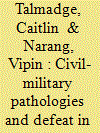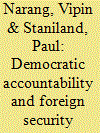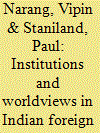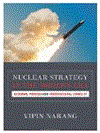|
|
|
Sort Order |
|
|
|
Items / Page
|
|
|
|
|
|
|
| Srl | Item |
| 1 |
ID:
160783


|
|
|
|
|
| Summary/Abstract |
This article uses an original data set, the Wartime Civil-military Relations Data Set, to test arguments about the causes of victory and defeat in war. Our analysis provides strong initial support for the notion that civil-military relations powerfully shape state prospects for victory and defeat. Specifically, states whose militaries have a significant internal role or whose regimes engage in coup-proofing appear to have a substantially lower probability of winning interstate wars, even when we account for the role of other important variables, including regime type and material capabilities. Crucially, our measures of civil-military relations include coup incidence but also move beyond it to detect more subtle indicators of civil-military relations. The resulting analysis should give us confidence in acknowledging the importance of nonmaterial variables in explaining war outcomes, while also paving the way for further research that can utilize and extend the data set.
|
|
|
|
|
|
|
|
|
|
|
|
|
|
|
|
| 2 |
ID:
160741


|
|
|
|
|
| Summary/Abstract |
Identifying the links between democracy and foreign security policy has proven elusive. This paper engages this research agenda by developing a novel theory of “accountability environments” and exploring it in the case of India. We hypothesize that the varying electoral salience of foreign security policy and the clarity of responsibility for policy outcomes combine to create different accountability environments in which politicians operate. Accountability environments determine the incentives that politicians face for devoting effort to external security issues. We illustrate the argument with evidence from India over time and across issue areas (India, Pakistan, and defense procurement/development). Scholars need to incorporate the complexities and diversity of representation and rule into the study of democratic politics and international relations.
|
|
|
|
|
|
|
|
|
|
|
|
|
|
|
|
| 3 |
ID:
124868


|
|
|
|
|
| Publication |
2013.
|
| Summary/Abstract |
Five prevailing myths about India's nuclear posture should be dispelled, exposing its posture as no longer as minimalist as the conventional wisdom asserts with significant, underappreciated implications for safety, regional security, and crisis stability.
|
|
|
|
|
|
|
|
|
|
|
|
|
|
|
|
| 4 |
ID:
158435


|
|
|
|
|
| Summary/Abstract |
This article traces the evolution of India’s nuclear strategy over the past 20 years, as it went from reluctant nuclear power to a mature nuclear weapons nation. It explores the various doctrinal and postural choices India has made, and confronts, as its threat environment evolves and as its institutions have matured. Most notably, it analyzes various options to address the dilemma of Pakistan’s tactical nuclear weapons threat, and how India can adjust its nuclear posture and strategy to possibly escape the paralysis induced by that threat.
|
|
|
|
|
|
|
|
|
|
|
|
|
|
|
|
| 5 |
ID:
163810


|
|
|
|
|
| Summary/Abstract |
Is India shifting to a nuclear counterforce strategy? Continued aggression by Pakistan against India, enabled by Islamabad's nuclear strategy and India's inability to counter it, has prompted the leadership in Delhi to explore more flexible preemptive counterforce options in an attempt to reestablish deterrence. Increasingly, Indian officials are advancing the logic of counterforce targeting, and they have begun to lay out exceptions to India's long-standing no-first-use policy to potentially allow for the preemptive use of nuclear weapons. Simultaneously, India has been acquiring the components that its military would need to launch counterforce strikes. These include a growing number of accurate and responsive nuclear delivery systems, an array of surveillance platforms, and sophisticated missile defenses. Executing a counterforce strike against Pakistan, however, would be exceptionally difficult. Moreover, Pakistan's response to the mere fear that India might be pursuing a counterforce option could generate a dangerous regional arms race and crisis instability. A cycle of escalation would have significant implications not only for South Asia, but also for the broader nuclear landscape if other regional powers were similarly seduced by the temptations of nuclear counterforce.
|
|
|
|
|
|
|
|
|
|
|
|
|
|
|
|
| 6 |
ID:
114254


|
|
|
|
|
| Publication |
2012.
|
| Summary/Abstract |
This article explores the intersection of strategic worldviews and domestic institutions in the creation of India's foreign policy.We first show that Indian electoral politics have weak links with foreign policy. Insulated bureaucracies and small groups of elites dominate policy making because most elected officials are focused on winning votes and building coalitions around other issues. The ideas of the strategic elite are thus very important. We then identify major strands of thought among these elites: specifically, the desire for autonomy, distance from alliances, and skepticism of binding international commitments. Though there is heterogeneity, these basic elements can be found across much of the political spectrum. This continuity, despite changes over time in international and domestic politics, suggests that India will continue to pursue freedom of action rather than becoming a close ally of the United States.
|
|
|
|
|
|
|
|
|
|
|
|
|
|
|
|
| 7 |
ID:
170576


|
|
|
|
|
| Summary/Abstract |
The most effective allied framework would employ deterrence by punishment at the nuclear level, and deterrence by denial at the conventional level.
|
|
|
|
|
|
|
|
|
|
|
|
|
|
|
|
| 8 |
ID:
143011


|
|
|
|
|
| Summary/Abstract |
What if nuclear aspirants get the bomb? How likely are they to use it? Which nuclear strategies might emerging nuclear powers adopt? These may seem like academic questions, but they are loaded with strategic significance. Different nuclear strategies have historically been associated with distinct types of risk. Some nuclear strategies are more likely to deter U.S. freedom of action; some more sharply increase the risk of accidental or unauthorized nuclear use. The type of nuclear posture or strategy a state is likely to choose, then, ought to affect the price the international community is willing to pay to stop or rollback emerging nuclear powers. These questions merit urgent answers. North Korea is believed to have at least a rudimentary plutonium-based nuclear weapons capability, is presently assessed to have a uranium enrichment capability to expand its fissile material stockpile, and periodically threatens to restart its plutonium production pathway. The international community is intensively trying to prevent Iran from achieving a nuclear weapons capability based on uranium enrichment. Much policy and academic energy has centered on trying to prevent the spread of nuclear weapons. But if these efforts fail, what next? Which nuclear strategy might these states choose?
|
|
|
|
|
|
|
|
|
|
|
|
|
|
|
|
| 9 |
ID:
134564


|
|
|
|
|
| Publication |
New Jersey, Princeton University Press, 2014.
|
| Description |
xi, 341p.Pbk
|
| Series |
Princeton studies in international history and politics
|
| Standard Number |
9780691159829
|
|
|
|
|
|
|
|
|
|
|
|
Copies: C:2/I:0,R:0,Q:0
Circulation
| Accession# | Call# | Current Location | Status | Policy | Location |
| 057945 | 355.0217/NAR 057945 | Main | On Shelf | General | |
| 058064 | 355.0217/NAR 058064 | Main | On Shelf | General | |
|
|
|
|
| 10 |
ID:
093024


|
|
|
|
|
| Publication |
2009.
|
| Summary/Abstract |
A probe of various regional power nuclear postures reveals that such postures, rather than simply the acquisition of nuclear weapons, can have differential effects on deterrence and stability dynamics. The India-Pakistan dyad is a useful candidate for exploring these various effects because the three regional power nuclear postures-catalytic, assured retaliation, and asymmetric escalation-have interacted with each other in South Asia. In particular, Pakistan's shift from a catalytic posture to an asymmetric escalation posture in 1998 against a continuous Indian assured retaliation posture allows the effects of nuclear posture to be isolated in an enduring rivalry in which many variables can be held constant. The asymmetric escalation posture may be "deterrence optimal" for Pakistan, suggesting that nuclear postures do have different effects on conflict dynamics, but it has also enabled Pakistan to more aggressively pursue longstanding revisionist preferences in India, triggering more frequent and intense crises on the subcontinent. Furthermore, the command and control procedures that Pakistan undertakes to make its asymmetric escalation posture credible amplify this instability. These procedures generate risks to the safety and security of Pakistan's nuclear assets, both at present and as India and Pakistan continue to dynamically evolve nuclear and conventional postures. The conclusions for South Asian and international security of this reality are grim.
|
|
|
|
|
|
|
|
|
|
|
|
|
|
|
|
| 11 |
ID:
151074


|
|
|
|
|
| Summary/Abstract |
How do states pursue nuclear weapons? Why do they select particular strategies to develop them, and how do these choices affect the international community's ability to prevent nuclear proliferation? The bulk of the proliferation literature focuses on why states want nuclear weapons. The question of how they pursue them, however, has largely been ignored. This question is important because how states try to acquire nuclear weapons—their strategies of nuclear proliferation—affects their likelihood of success and thus the character of the nuclear landscape. Four strategies of proliferation are available to states: hedging, sprinting, hiding, and sheltered pursuit. Nuclear acquisition theory explains why a proliferator might select one strategy over the others at a given time. Empirical codings from the universe of nuclear pursuers, combined with a detailed plausibility probe of India's long march to acquiring nuclear weapons—including novel details—establish the analytical power of the theory. Different strategies of proliferation offer different opportunities and vulnerabilities for nuclear proliferation and nonproliferation, with significant implications for international security.
|
|
|
|
|
|
|
|
|
|
|
|
|
|
|
|
| 12 |
ID:
119959


|
|
|
|
|
| Publication |
2013.
|
| Summary/Abstract |
Existing nuclear deterrence scholarship evinces a pervasive "existential bias," assuming that once a state merely possesses nuclear weapons, it should be able to deter armed conflict. The empirical literature expresses this bias by simply dichotomously coding a state based on whether it has nuclear weapons, thereby treating all nuclear states as equivalent. Thus, whether nuclear weapons deter conflict, and how much is required to do so, is unclear. This article shifts the unit of analysis away from nuclear weapons to postures, hypothesizing that different nuclear postures are distinct and generate differential deterrent power, particularly amongst the non-superpower states which comprise the lion's share of nuclear powers. I find that an asymmetric escalation nuclear posture uniquely deters conflict initiation and escalation. Not only do small arsenals have little deterrence success, but I find that even assured retaliation postures fail to deter intense conventional conflict. This suggests that the deterrence dividend is distributed unequally across nuclear powers, and that states may need to do more than simply acquire nuclear weapons to successfully deter conventional attacks.
|
|
|
|
|
|
|
|
|
|
|
|
|
|
|
|
|
|
|
|
|